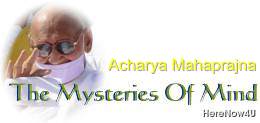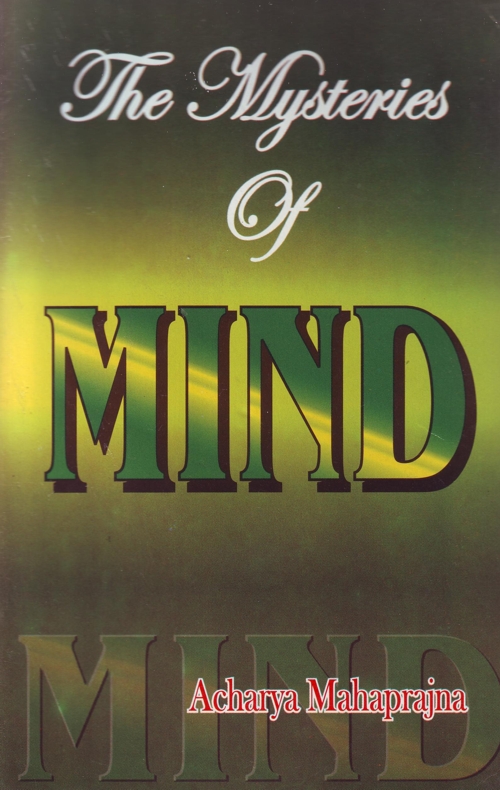
The first task of philosophy is to release super-mental consciousness capable of perceiving subtle truths. That is also the task of meditation. The second task of philosophy is to train the mind. Subtle truths can be perceived by the subtle mind only and not by the gross mind. There are various methods of training the mind. Bhavakriya is one of them. It means a balanced coordination between action and the mind or a synthesis between the two. They should be made to run parallel to each other. If they run in different directions, there can be no synthesis. The mind should be concentrated on what we are doing. It should not be estranged from action. The anecdote about a philosopher who fell into a ditch while his mind was soaring high into the sky is well known. An old woman who rescued the philosopher from the ditch remarked. "You should sometimes see the earth also." What happened to the philosopher is a common experience. In our thinking we often wander in the wilderness and fail to see what lies immediately before us. The moments in which we try to yoke the mind to action are rare. Meditation is the only means of yoking the mind. Mental discipline grows with the maturing of the process of meditation. We should do every thing with the mind in it. Bhavakriya is an important area of philosophy. It makes meditation a way of life rather than an exercise for an hour or two. One who has accomplished Bhavakriya will do every act of his life with a meditative mind. Bhavakriya does not divide the mind. It does not split the personality. It is not absentmindedness. It is a perfect integration of personality. It makes the mind subtle and capable of perceiving subtle truths.
The second aspect of the training of the mind is the development of imagination and will power. The purpose of this training is to enable the mind to see things clearly. Imagination gives a definite and clear form to our ideals. Bhavana or suggestion through symbols activates the will, which carries us to the ideal we have set before us.
Concentration is the third aspect of the training of the mind. Fickleness is the natural tendency of the mind. The mind always remains scattered and never sticks to a single point. A stable mind is more or less an unnatural entity. It is often compared to mercury, which cannot be arrested. You cannot arrest the mental processes. People have been wondering for thousands of years how to arrest the mental processes. Man is an ingenious being and has devised methods of making small balls of mercury. He may one day succeed in arresting the fleeting mental processes also.
Concentration fixes the mind at a definite point. This releases enormous mental energies. But concentration needs a lot of exertion. It is difficult to concentrate the mind even for a few hours. An hour's concentration accumulates a lot of energy.
Practice of preksa is the fourth method of training the mind. The term preksa means to see, to perceive. The mind has to be trained in the art of perception. Till now we have trained our minds in the art of thinking. And that is why we are always busy thinking. We have, therefore, to provide the mind with a fresh training so that it begins to perceive instead of thinking. Thinking takes place in the outer sphere of consciousness. Perception implies a deep penetration into the depths of consciousness. Once the mind has started perceiving, thinking subsides or becomes only a secondary occupation of the mind. In the absence of direct personal experience we go on acquiescing in traditional ideas and views uncritically. We accept such ideas and views to be true. The result is that in critical situations we become assailed by doubts and misgivings. Direct perception disperses doubts and misgivings and gives us conviction. We often say, "I have perceived this with my own eyes." What we mean is that this is our perception. Perception is the soundproof of the existence of what has been perceived. Ordinarily thinking comes first and perception occupies a secondary place. We have to reverse the order. First perceive and then think.
Preksa meditation means following the breath with the mind or in yoking the mind to breath. It means perceiving breath through the mind and not through the eye. You cannot perceive breath with the eye. There is no place for thinking in this process. This perceiving is not concentration. Concentration is a process parallel to the process of perceiving. The process of perceiving does not aim at concentration of the mind. It is an attempt to develop the power of neutral or passionless perception. Perceiving and knowing are the inherent characteristics of consciousness. We try to activate these characteristics through preksa meditation. In the course of this endeavour concentration will take place of its own accord. Concentration, in a sense, is a by-product.
In Preksa meditation we try to perceive the body. First we see the form of the body, its external appearance. Then we try to carry the mind inside the body so that it may see the inner constituents of the body. We see the gross and subtle vibrations of the body. The human body is a part and parcel of the universe in which we live. It is a replica of the universe. It is wrong to think that the mind is confined into the brain only. Like consciousness it has several sastra. One stratum of consciousness lies at the level of the sense organs. Another exists at the level of the cells of the body. Every cell has its own brain. We try to perceive consciousness at all its levels and to arouse and expand it. Perceiving the entire body means perceiving the cells and to activate them. It is necessary to break the inertia of the cells so that they may become conscious. Every cell of the body is seized by inertia. We have not yet tried to break this inertia. Every cell has the potential to become united with consciousness and to be guided by it. When it is not united with consciousness, it remains inert. Every cell, is biologically active. The sensory and motor nerves work continuously. The sensation caused by the prick of a thorn is immediately carried to the spinal cord and through it to the brain centres. The motor nerves come to act immediately. The cells become active and the hands proceeds to pick out the thorn. The sensory and motor nerves work within the body. Their actions are the result of the sensitivity of the nervous system.
However, the conscious centres which enable us to perceive subtle things have to be activated and freed from inertia. Meditative perception of the centres of consciousness is, therefore, to be repeated time and again. Ultimately our super-sensuous consciousness becomes manifest and we can perceive subtle truths.
Preksa meditation is not only an attempt to see the constituents of the body, it also aims at perceiving all the objects of the world in their true colours, Dharmya dhyana and vicaya dhyana are also parts of preksa meditation. They reveal to us the internal structure of objects.
Before we sit down to meditate on a plant we do not see its internal structure and system. We do not know its potential. But once we have begun meditating on it and have become absorbed in the meditation, it will reveal to us its constitution and functions. Its movements are symbolical and they will reveal to us its essence. It will appear to us as if we were turning the pages of a book and reading every word and line on them.
Preksa meditation not only reveals to us the transformations of the body but also of each, and every object. It is in this respect, a very valuable method of perception and a new one. It will rehabilitate philosophy in its native base. The links of such philosophical thinking, which had been broken in the Middle Ages, will be rejoined and we will be able to practise true knowledge without the aid of logic and reasoning.
 Acharya Mahaprajna
Acharya Mahaprajna

